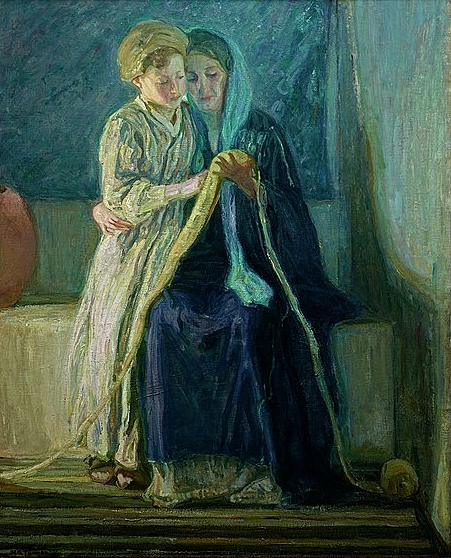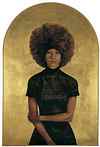
African-American Art
with an emphasis on representational art

(above: Henry Ossawa Tanner, Christ and His Mother Studying the Scriptures, 1909, oil on canvas, 48.7 x 40 inches, Dallas Museum of Art. Public domain, via Wikimedia Commons*)
Introduction
This section of the Traditional Fine Arts Organization (TFAO) catalogue Topics in American Art is devoted to the topic "African-American Art." Articles and essays specific to this topic published in TFAO's Resource Library are listed at the beginning of the section. Clicking on titles takes readers directly to these articles and essays. The date at the end of each title is the Resource Library publication date.
After articles and essays from Resource Library are links to valuable online resources found outside our website. Links may be to museums' articles about exhibits, plus much more topical information based on our online searches. Following online resources may be information about offline resources including museums, DVDs, and paper-printed books, journals and articles.
We recommend that readers search within the TFAO website to find detailed information for any topic. Please see our page How to research topics not listed for more information.
Articles and essays from Resource Library in chronological order:
2014-
Themes and Variations: It's What Artists Do; essay by Will South (4/6/16) Themes and Variations was written to accompany the 2016 exhibit REMIX: Themes and Variations in African-American Art, on view at the Columbia Museum of Art. Excerpt from the essay: "The 45 works in REMIX: Themes and Variations in African-American Art illustrate how art reflects this ongoing tension between innovation and change and the cultural search for stability and continuity. A result of this tension is that the stories we tell get updated: The hero of one age becomes the hero of another only with a different mask, costume, and language. His or her adventures take on different details, but the story is nonetheless familiar." Article includes wall text.
This is the REMIX; essay by Jonell Logan (4/6/16) This essay was written to accompany the 2016 exhibit REMIX: Themes and Variations in African-American Art, on view at the Columbia Museum of Art. Excerpt from the essay: "Held as humankind's highest form of creative expression, painting and sculpture are strictly organized and monetized by the art world. The benchmark by which all artwork is compared is European art -- specifically painting from the Renaissance. From Greek and Roman sculptors to Michelangelo; from Goya to Gauguin; and even from Pollock to Hirst, the art world master narrative is constructed through the European lens -- in spite of artistic traditions from Africa and other non-western communities.... While some may argue that an exhibition of only African-American artists excludes portions of the creative community, I would like to offer an alternative consideration. REMIX: Themes and Variations in African-American Art provides us with an opportunity to not only celebrate and recognize African-American artists, but to question the notion of master narrative. We are encouraged to expand our understanding of American art and culture through the visual sampling, mastering, and remixing of our common visual language, while exploring the complexities and diversity that is the black community."
 Witness:
Art and Civil Rights in the Sixties (4/6/15) Blanton Museum of Art presented
Witness: Art and Civil Rights in the Sixties, an exhibition of approximately
100 works by 66 artists that explores how painting, sculpture, drawing,
printmaking, and photography not only responded to the political and social
turmoil of the era, but also helped influence its direction. Organized by
the Brooklyn Museum in New York, the exhibition highlights the wide-ranging
aesthetic approaches used to address the struggle for civil rights. Organized
thematically, the exhibition includes sections titled Integrate/Educate;
American Nightmare; Presenting Evidence; Politicizing Pop; Black Is Beautiful;
Sisterhood; Global Liberation; and Beloved Community. (left: thumbnail
image: Barkley Hendricks, Lawdy Mama, 1969, Oil and gold leaf on
canvas, 53 3/4 x 36 1/4 inches. Courtesy of the Brooklyn Museum)
Witness:
Art and Civil Rights in the Sixties (4/6/15) Blanton Museum of Art presented
Witness: Art and Civil Rights in the Sixties, an exhibition of approximately
100 works by 66 artists that explores how painting, sculpture, drawing,
printmaking, and photography not only responded to the political and social
turmoil of the era, but also helped influence its direction. Organized by
the Brooklyn Museum in New York, the exhibition highlights the wide-ranging
aesthetic approaches used to address the struggle for civil rights. Organized
thematically, the exhibition includes sections titled Integrate/Educate;
American Nightmare; Presenting Evidence; Politicizing Pop; Black Is Beautiful;
Sisterhood; Global Liberation; and Beloved Community. (left: thumbnail
image: Barkley Hendricks, Lawdy Mama, 1969, Oil and gold leaf on
canvas, 53 3/4 x 36 1/4 inches. Courtesy of the Brooklyn Museum)
Welcome to the World of Mr. Imagination; essay by Martha Henry (3/19/15) Welcome to the World of Mr. Imagination was on display in 2015 at Intuit: The Center for Intuitive and Outsider Art. Quoted from the essay: "Mr. Imagination was a messenger who preached that the power of art could transform lives and transcend adversity. He believed everyone could be an artist by simply using their imagination. He lived by example, creating a world where art and artist were inseparable. The many self-likenesses in his art were more than an exploration and deification of self but an affirmation of a spiritual belief that we are one. 'My art helps to recycle the past. It helps us to remember and imagine who we are and where we came from.'"
History Refused to Die-Alabama's African-American Self-Taught Artists in Context (3/13/15) In commemoration of the fiftieth-anniversary of the Selma-to-Montgomery March, the Montgomery Museum of Fine Arts presented a collection of works by a group of Alabama's most important self-taught artists who were active in the latter part of the twentieth century. These artists -- Thornton Dial and the Dial Family, Lonnie Holley, Joe Minter, and others -- responded to the cultural and social environment of their times through their art. Using found objects as well as traditional art materials, they created works of great power that speak to the roles of Black people throughout their history in the state, from slavery to the Civil Rights Movement. Article includes wall panel texts and extended labels.
Common Ground: African American Art from the Flint Institute of Arts, the Kalamazoo Institute of Arts, & the Muskegon Museum of Art (3/9/15) Common Ground, on display at the Flint Institute of Arts in 2015, highlights some of the most important African American artists from the 19th century to present day through the collections of three Michigan museums. This exhibition surveys the history of African American art through 67 works of art in various mediums, including painting, sculpture, and works on paper.
A House We Should All Know Better; essay by Brett Busang (12/3/14) Busang's essay discusses the Washington neighborhood, home and artistic career of Lois Maillou Jones.
 Sargent
Claude Johnson: A Masterpiece Restored (2/28/14) Sargent
Claude Johnson (1888-1967) was one of the first African American artists
in California to achieve a national reputation. He worked as a painter,
printmaker, and ceramicist, but is best known as a sculptor. Under
the auspices of the Federal Arts Project (FAP), Johnson carved a 22-foot-long
redwood relief of musicians, animals, birds, and plants as a screen for
a pipe organ in the music hall of the California School for the Blind in
Berkeley. The article contains several images. (left: thumbnail image:
Sargent Claude Johnson, 1888-1967. Untitled (screen for pipe organ),
1937, Carved, painted, and gilded redwood. The Huntington Library, Art Collections,
and Botanical Gardens. Purchased with funds from the Art Collectors' Council,
the Connie Perkins Endowment, and the Virginia Steele Scott Acquisition
Fund for American Art in honor of George Abdo and Roy Ritchie. 2011.5)
Sargent
Claude Johnson: A Masterpiece Restored (2/28/14) Sargent
Claude Johnson (1888-1967) was one of the first African American artists
in California to achieve a national reputation. He worked as a painter,
printmaker, and ceramicist, but is best known as a sculptor. Under
the auspices of the Federal Arts Project (FAP), Johnson carved a 22-foot-long
redwood relief of musicians, animals, birds, and plants as a screen for
a pipe organ in the music hall of the California School for the Blind in
Berkeley. The article contains several images. (left: thumbnail image:
Sargent Claude Johnson, 1888-1967. Untitled (screen for pipe organ),
1937, Carved, painted, and gilded redwood. The Huntington Library, Art Collections,
and Botanical Gardens. Purchased with funds from the Art Collectors' Council,
the Connie Perkins Endowment, and the Virginia Steele Scott Acquisition
Fund for American Art in honor of George Abdo and Roy Ritchie. 2011.5)
Please:
click here to view other online resources
click here to view online videos
click here to review suggested books
click here to review DVD and VHS videos
click here to hear online audio
Musical accompanyment:
African-American Band Music & Recordings, 1883 to 1923, source: Library of Congress Celebrates the Songs of America Collection
![]() Return to Topics in American Representational Art
Return to Topics in American Representational Art
TFAO catalogues:
Links to sources of information outside of our website are provided only as referrals for your further consideration. Please use due diligence in judging the quality of information contained in these and all other web sites. Information from linked sources may be inaccurate or out of date. TFAO neither recommends or endorses these referenced organizations. Although TFAO includes links to other websites, it takes no responsibility for the content or information contained on those other sites, nor exerts any editorial or other control over them. For more information on evaluating web pages see TFAO's General Resources section in Online Resources for Collectors and Students of Art History.
 Search Resource Library
Search Resource Library
Copyright 2022 Traditional Fine Arts Organization, Inc., an Arizona nonprofit corporation. All rights reserved.